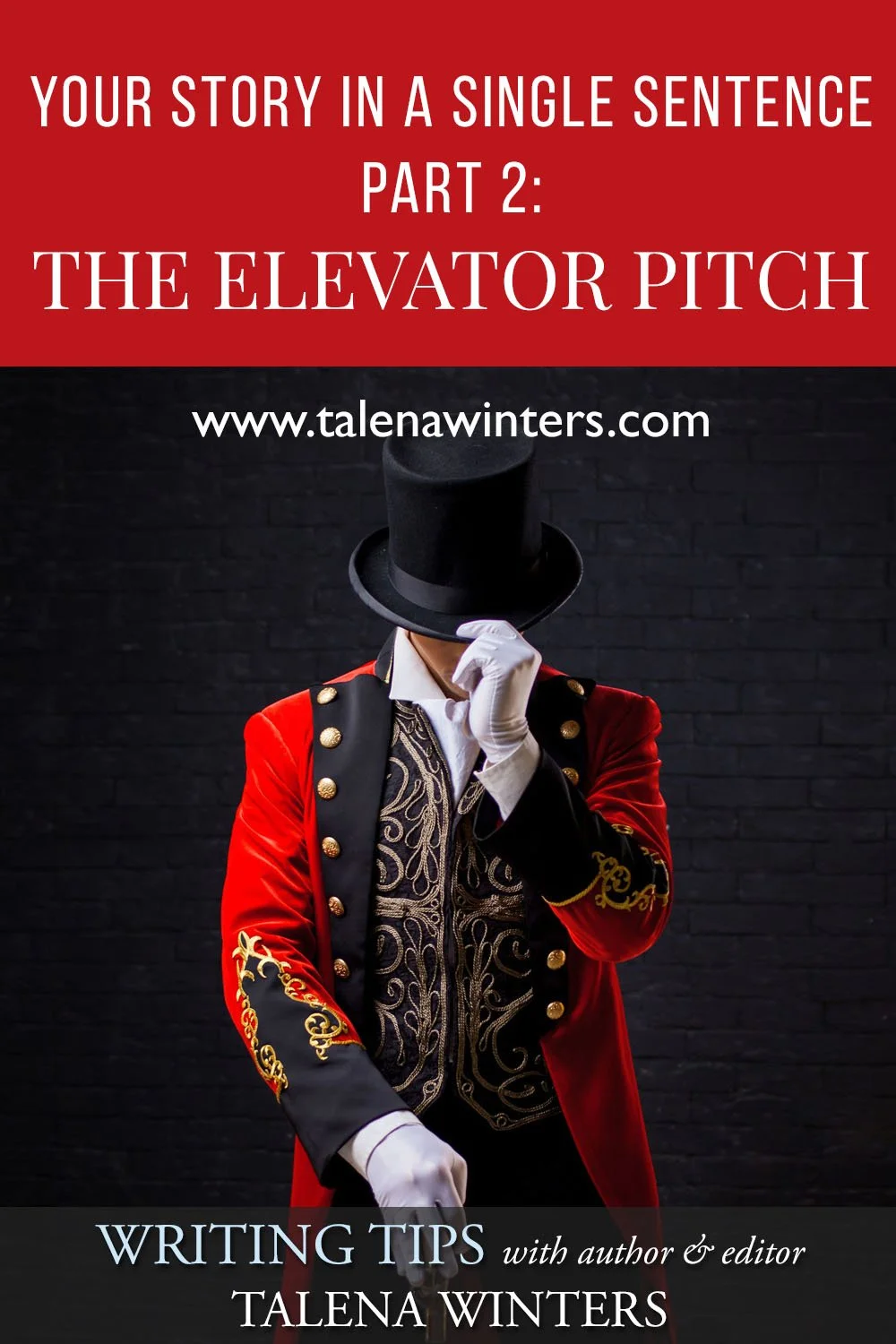Your Story in a Single Sentence Part 2: The Elevator Pitch
Picture this: You step on an elevator to go up exactly three floors. The elevator has one other occupant, and you are startled to recognize a mover-and-shaker in the writing/publishing/movie-making industry, one of your storytelling heroes. You nod at each other politely, but your mind is racing.
I’ve got thirty seconds alone in an elevator with [insert name here]. This is the moment most writers only dream of! I need to get them interested in my project!
So, bravely, you introduce yourself, say you’re a writer, and then ask if they’d like to hear about this great project you think they’d be interested in. And, because they are an awesome human being, they say yes.
This is your moment. The spotlight is on you. You have their attention. And then you say… what?
This is exactly the kind of situation for which you need an elevator pitch. But let’s face it, most of us aren’t going to get to step into an elevator with Joss Whedon.
What you will need to do at many points in your career is get someone else interested enough in your book to take a closer look at it, whether it be an agent, an editor, a publisher, or a customer walking by your book signing table. And you’ll have thirty seconds or less to do it in.
So, let’s figure out how to build an elevator pitch, shall we?
Step One: Know What Your Book is About
This goes without saying, right? But let me be more clear: you need to be able to state what your book is about in an intriguing way and in a single sentence.
Yep. One sentence.
Okay, two maximum, because it’s important to breathe, right?
That is the reason we need to start with a Log Line.
I talked about log lines in part 1 of this series because they are the basis of so much of what you will need for your book—outline, blurb writing, marketing, and yes, elevator pitches. In fact, I’m doing Elevator Pitches next because there is hardly any work that needs to be done to shift a Log Line into an Elevator Pitch. So, to review, here is the formula to make a Log Line:
Those are also the basic elements we draw from when creating our Elevator Pitches. So, now we know what is similar, let’s take a look at what we need to tweak to hook our potential reader.
Step Two: Know What You’re Trying to Accomplish
Your log line is for you, to guide you as you write your story. It needs to contain all the parts of your plot so you know where you are headed. But the elevator pitch doesn’t.
Your elevator pitch is for other people. What it should include are the elements that will give your audience an appropriate expectation of what your story is about and make them want to find out more.
“Your elevator pitch should include the elements that will give your audience an appropriate expectation of what your story is about and make them want to find out more.”
Your log line is an outlining tool. Your elevator pitch is a marketing tool. And that’s the difference.
You can skip certain things from the log line as long as the primary conflict is included and the whole thing sounds interesting. You’ll also want to add a few things. While the log line may talk about only the characters and conflicts and stakes, the elevator pitch can include a bit about the cool world/concept or comparable titles (called “comps”) that will impart the immediate flavour of your story to someone familiar with the genre.
Here is an example:
For The Undine’s Tear, my log line goes like this:
In a post-Atlantean culture where human men are enslaved for power and reproduction, a powerful undine healer must choose between her duty to save her people or saving her own sanity and the man she loves before the stone that protects her nation fails completely.
Now, I know exactly what all those things mean. To a stranger who has no clue what my world or story is about, that will pretty much sound like gobbledygook. So, here is the elevator pitch I give when people ask about my book:
It’s a young adult epic historical fantasy about the same intensity as Divergent or The Hunger Games. Set in 1799, it’s an alternate history about a post-Atlantean society of mermaids called undines who have lost the ability to produce their own males, so they have to capture human men to survive. A powerful healer named Calandra has been raised to save the stone that protects her people—unfortunately, all the powerful healers in her history have gone insane, so she’s worried she’ll go crazy and kill everyone before she has a chance to save them.
You can see I included my protagonist’s primary goals and conflicts but left out the romance. I also gave a flavour of the world and setting, and used comps to help set appropriate reader maturity expectations—it’s young adult, but a more mature young adult, and it has some violence some parents may not want their children to read, but many adults may love to read themselves. And, of course, I explained the less-familiar term “undines” for those who may pass that word over but grab onto “mermaids,” which they can visualize.
When you are creating your elevator pitch, these are the elements to include:
genre
comps
themes that appeal to your target audience
what makes your story cool
any or all the elements in the log line
One further point I’d like to add is that The Undine’s Tear is the first book of a trilogy, each of which is quite long (you might even say epic, haha), and contains many more elements and story arcs than I included in either my log line or my pitch.
When you are creating your pitch and log line, you want to focus on the primary conflicts of the story. Other conflicts and characters should only be there to support and enhance the primary conflicts and themes. This is how you get it down to one sentence.
Yes, the other stuff matters. But all you’re trying to do is grab someone’s interest and set expectations. All those other elements are the treasures they find between your book’s covers.
And yes, I can rattle that pitch off from memory. Which leads me to my last point:
Step Three: Make it Automatic
It does no good to work out your elevator pitch and your log line if the moment you are asked about your book, your mind goes blank or you stumble over your words in your nervousness.
Smooth: Say it out loud, rearranging parts that you stumble over.
Memorize: Say it about three dozen times or more until it rolls off your tongue like caramel.
Practice: Say it to other people. Start with your long-suffering friends and family, if you must, but practice. That way, when you see Joss in the elevator (or just a random stranger at your table) and he politely asks you about your book, you’ll launch into your pitch without even thinking about it.
Ready? The curtains open in 3, 2, 1… the spotlight’s all yours.
Happy pitching!
Talena Winters is a freelance developmental editor, independent author, magazine writer, and tea and silver lining addict. She specializes in helping struggling self-published fiction and memoir authors unlock their inner writing wizards and unleash story magic. See her editing services here.







An appropriately-crafted log line may not be a magic wand to fix plot problems, but it comes close. Check out these three common causes for “project flame-out” to help you fix your story.